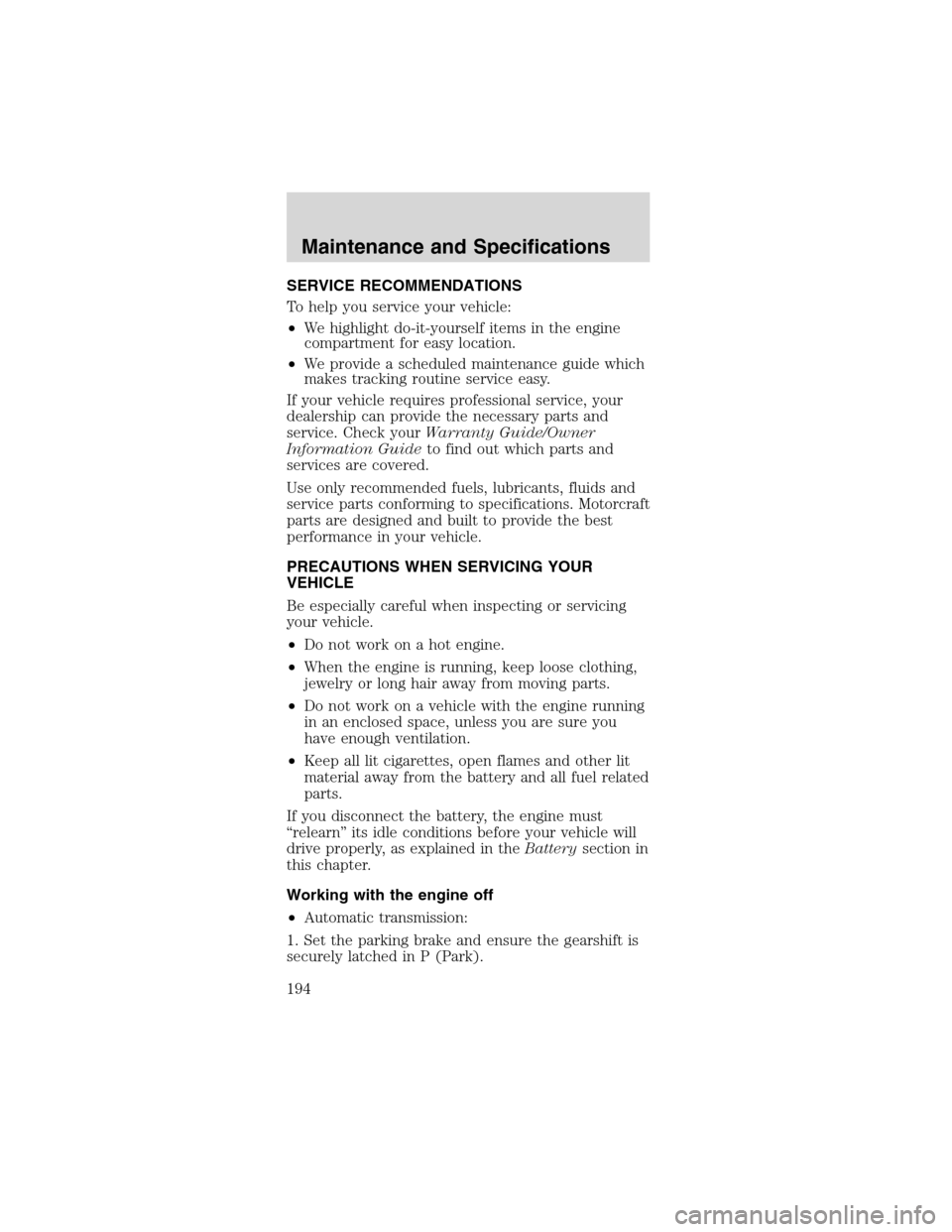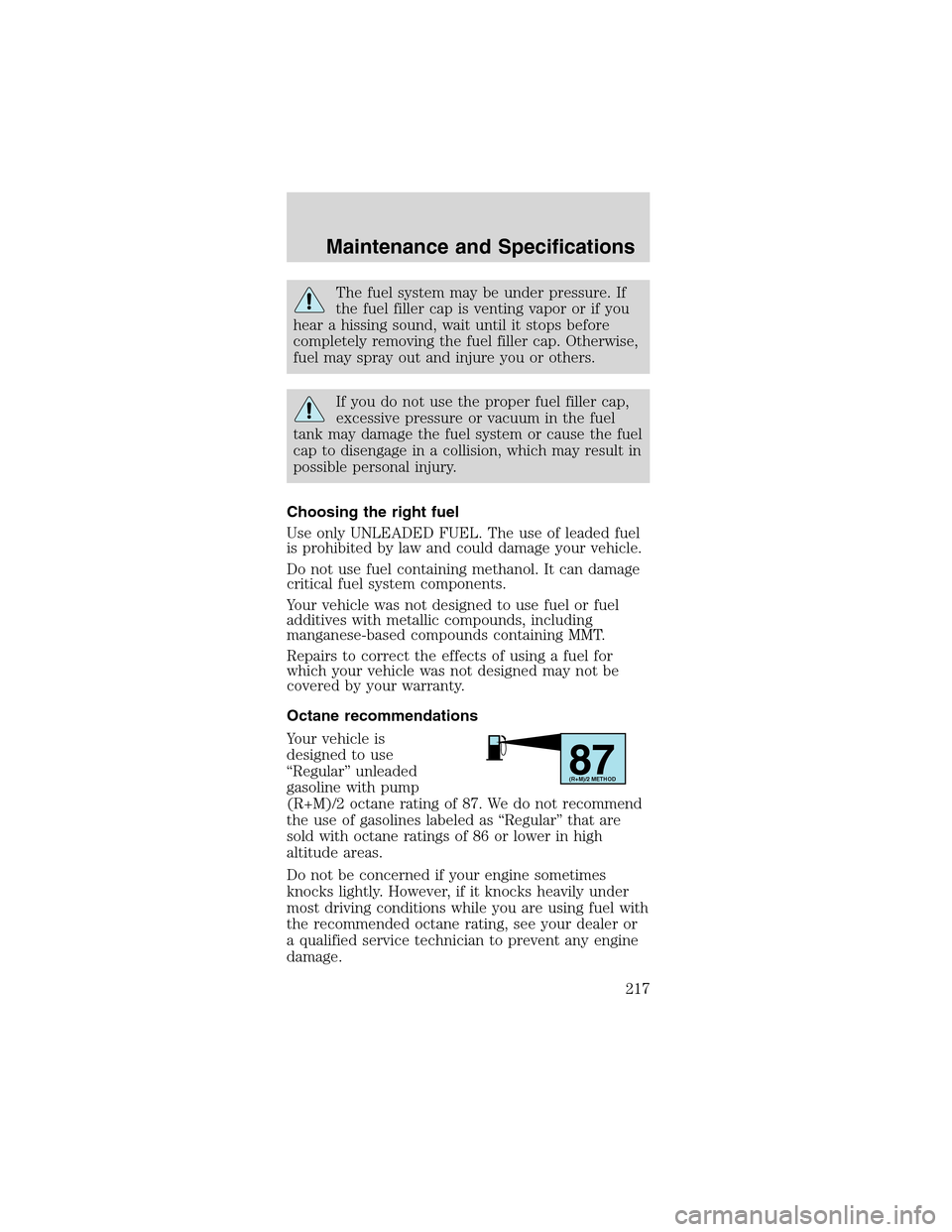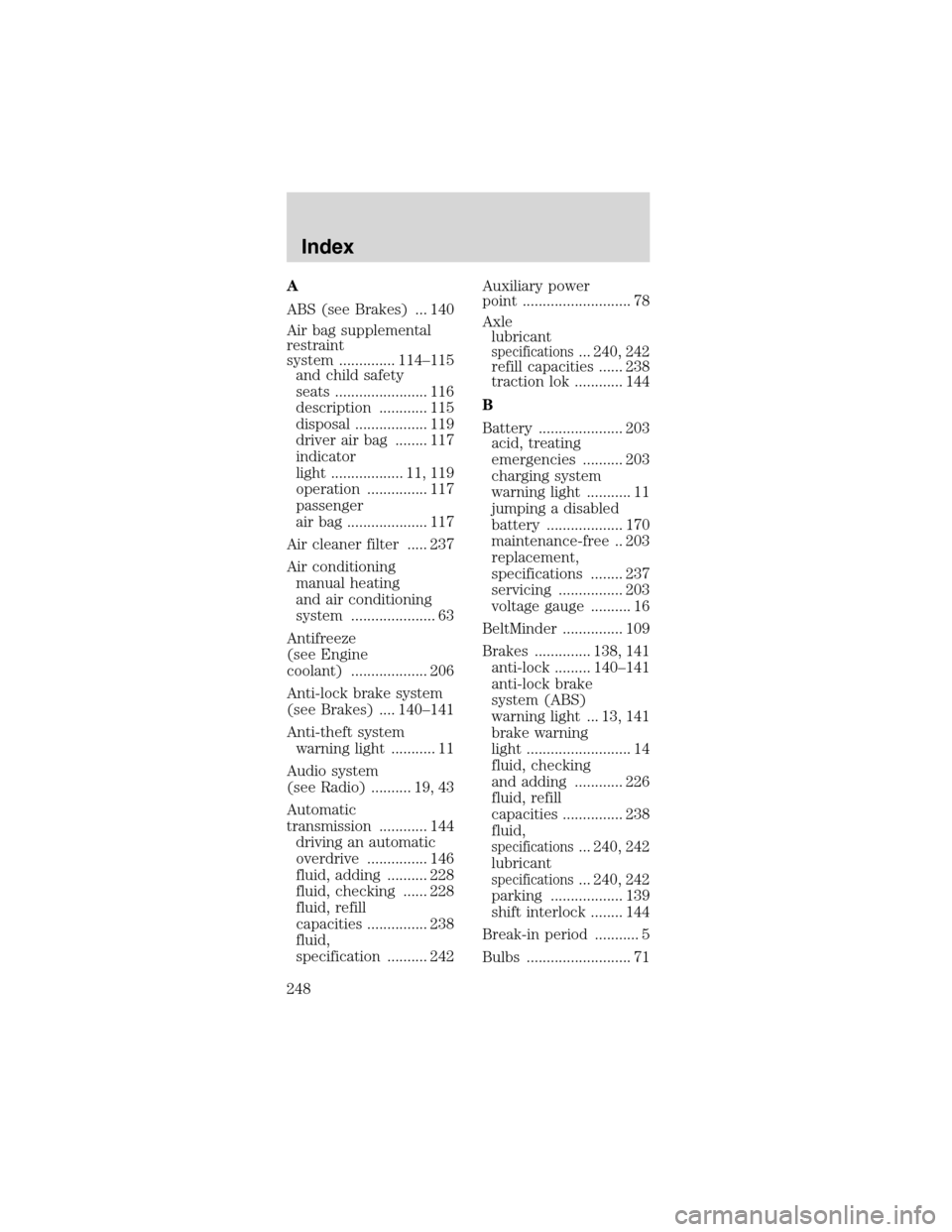2003 FORD MUSTANG air condition
[x] Cancel search: air conditionPage 194 of 256

SERVICE RECOMMENDATIONS
To help you service your vehicle:
•We highlight do-it-yourself items in the engine
compartment for easy location.
•We provide a scheduled maintenance guide which
makes tracking routine service easy.
If your vehicle requires professional service, your
dealership can provide the necessary parts and
service. Check yourWarranty Guide/Owner
Information Guideto find out which parts and
services are covered.
Use only recommended fuels, lubricants, fluids and
service parts conforming to specifications. Motorcraft
parts are designed and built to provide the best
performance in your vehicle.
PRECAUTIONS WHEN SERVICING YOUR
VEHICLE
Be especially careful when inspecting or servicing
your vehicle.
•Do not work on a hot engine.
•When the engine is running, keep loose clothing,
jewelry or long hair away from moving parts.
•Do not work on a vehicle with the engine running
in an enclosed space, unless you are sure you
have enough ventilation.
•Keep all lit cigarettes, open flames and other lit
material away from the battery and all fuel related
parts.
If you disconnect the battery, the engine must
“relearn”its idle conditions before your vehicle will
drive properly, as explained in theBatterysection in
this chapter.
Working with the engine off
•Automatic transmission:
1. Set the parking brake and ensure the gearshift is
securely latched in P (Park).
Maintenance and Specifications
194
Page 217 of 256

The fuel system may be under pressure. If
the fuel filler cap is venting vapor or if you
hear a hissing sound, wait until it stops before
completely removing the fuel filler cap. Otherwise,
fuel may spray out and injure you or others.
If you do not use the proper fuel filler cap,
excessive pressure or vacuum in the fuel
tank may damage the fuel system or cause the fuel
cap to disengage in a collision, which may result in
possible personal injury.
Choosing the right fuel
Use only UNLEADED FUEL. The use of leaded fuel
is prohibited by law and could damage your vehicle.
Do not use fuel containing methanol. It can damage
critical fuel system components.
Your vehicle was not designed to use fuel or fuel
additives with metallic compounds, including
manganese-based compounds containing MMT.
Repairs to correct the effects of using a fuel for
which your vehicle was not designed may not be
covered by your warranty.
Octane recommendations
Your vehicle is
designed to use
“Regular”unleaded
gasoline with pump
(R+M)/2 octane rating of 87. We do not recommend
the use of gasolines labeled as“Regular”that are
sold with octane ratings of 86 or lower in high
altitude areas.
Do not be concerned if your engine sometimes
knocks lightly. However, if it knocks heavily under
most driving conditions while you are using fuel with
the recommended octane rating, see your dealer or
a qualified service technician to prevent any engine
damage.
87(R+M)/2 METHOD
Maintenance and Specifications
217
Page 222 of 256

•Using the air conditioner or defroster may reduce
fuel economy.
•You may want to turn off the speed control in
hilly terrain if unnecessary shifting between third
and fourth gear occurs. Unnecessary shifting of
this type could result in reduced fuel economy.
•Warming up a vehicle on cold mornings is not
required and may reduce fuel economy.
•Resting your foot on the brake pedal while driving
may reduce fuel economy.
•Combine errands and minimize stop-and-go
driving.
Maintenance
•Keep tires properly inflated and use only
recommended size.
•Operating a vehicle with the wheels out of
alignment will reduce fuel economy.
•Use recommended engine oil. Refer toLubricant
specificationsin this chapter.
•Perform all regularly scheduled maintenance
items. Follow the recommended maintenance
schedule and owner maintenance checks found in
your vehicle scheduled maintenance guide.
Conditions
•Heavily loading a vehicle or towing a trailer may
reduce fuel economy at any speed.
•Carrying unnecessary weight may reduce fuel
economy (approximately 0.4 km/L [1 mpg] is lost
for every 180 kg [400 lb] of weight carried).
•Adding certain accessories to your vehicle (for
example bug deflectors, rollbars/light bars,
running boards, ski/luggage racks) may reduce
fuel economy.
•Using fuel blended with alcohol may lower fuel
economy.
•Fuel economy may decrease with lower
temperatures during the first 12–16 km (8–10
miles) of driving.
Maintenance and Specifications
222
Page 248 of 256

A
ABS (see Brakes) ... 140
Air bag supplemental
restraint
system .............. 114–115
and child safety
seats ....................... 116
description ............ 115
disposal .................. 119
driver air bag ........ 117
indicator
light .................. 11, 119
operation ............... 117
passenger
air bag .................... 117
Air cleaner filter ..... 237
Air conditioning
manual heating
and air conditioning
system ..................... 63
Antifreeze
(see Engine
coolant) ................... 206
Anti-lock brake system
(see Brakes) .... 140–141
Anti-theft system
warning light ........... 11
Audio system
(see Radio) .......... 19, 43
Automatic
transmission ............ 144
driving an automatic
overdrive ............... 146
fluid, adding .......... 228
fluid, checking ...... 228
fluid, refill
capacities ............... 238
fluid,
specification .......... 242Auxiliary power
point ........................... 78
Axle
lubricant
specifications... 240, 242
refill capacities ...... 238
traction lok ............ 144
B
Battery ..................... 203
acid, treating
emergencies .......... 203
charging system
warning light ........... 11
jumping a disabled
battery ................... 170
maintenance-free .. 203
replacement,
specifications ........ 237
servicing ................ 203
voltage gauge .......... 16
BeltMinder ............... 109
Brakes .............. 138, 141
anti-lock ......... 140–141
anti-lock brake
system (ABS)
warning light ... 13, 141
brake warning
light .......................... 14
fluid, checking
and adding ............ 226
fluid, refill
capacities ............... 238
fluid,
specifications... 240, 242
lubricant
specifications... 240, 242
parking .................. 139
shift interlock ........ 144
Break-in period ........... 5
Bulbs .......................... 71
Index
248
Page 249 of 256

C
Capacities for
refilling fluids .......... 238
Cargo net ................... 78
CD player .................. 43
CD-single premium ... 19
Certification Label .. 243
Changing a tire ....... 165
Child safety
restraints ................. 120
child safety
belts ....................... 120
Child safety seats .... 123
attaching with
tether straps ......... 127
in front seat .......... 125
in rear seat ............ 125
Cleaning your vehicle
engine
compartment ......... 188
instrument panel .. 190
interior ................... 191
plastic parts .......... 190
washing .................. 187
waxing ................... 187
wheels .................... 188
wiper blades .......... 190
Climate control
(see Air conditioning
or Heating) ................ 63
Clock .............. 24, 34, 48
Clutch
adjusting ................ 228
operation while
driving ................... 150
recommended
shift speeds ........... 151Console ...................... 84
Controls
power seat ............. 100
Convertible ................ 85
cleaning ................. 192
installation of
the boot ................... 86
lowering the
convertible top ........ 85
raising the
convertible top ........ 87
Coolant
checking and
adding .................... 206
refill
capacities ....... 212, 238
specifications... 240, 242
Cruise control
(see Speed control) .. 80
Customer
Assistance ................ 157
Ford accessories
for your vehicle .... 192
Ford Extended
Service Plan .......... 178
Getting assistance
outside the U.S.
and Canada ........... 183
Getting roadside
assistance .............. 157
Getting the service
you need ............... 176
Ordering additional
owner’s literature . 184
The Dispute
Settlement Board . 179
Utilizing the
Mediation/Arbitration
Program ................. 183
Index
249
Page 251 of 256

running out
of
fuel ......................... 218
safety information
relating to
automotive fuels ... 214
Fuses ........................ 160
G
Gas cap
(see Fuel cap) ... 12, 216
Gas mileage
(see
Fuel economy) ........ 219
Gauges ....................... 15
battery voltage
gauge ....................... 16
engine coolant
temperature
gauge ....................... 15
engine oil pressure
gauge ....................... 16
fuel gauge ................ 16
odometer ................. 17
speedometer ........... 17
tachometer .............. 17
trip odometer .......... 18
GAWR (Gross Axle
Weight Rating) ........ 154
definition ............... 154
driving with a
heavy load ............. 154
location .................. 154
GVWR (Gross Vehicle
Weight Rating) ........ 154
calculating ............. 154
definition ............... 154
driving with a
heavy load ............. 154
location .................. 154H
Hazard flashers ....... 158
Head restraints ......... 99
Headlamps ................. 67
aiming ................ 68–69
bulb specifications .. 71
daytime running
lights ........................ 67
flash to pass ............ 68
high beam ......... 10, 68
replacing bulbs ....... 72
turning on and off .. 67
warning chime ........ 15
Heating
heating and air
conditioning
system ..................... 63
Hood ........................ 196
I
Ignition ............. 133, 242
removing the key .. 153
Infant seats (see
Safety seats) ........... 123
Inspection/maintenance
(I/M) testing ............ 224
Instrument panel
cleaning ................. 190
cluster ...................... 10
lighting up panel
and interior ............. 68
J
Jack .......................... 165
positioning ............. 165
storage ................... 165
Index
251